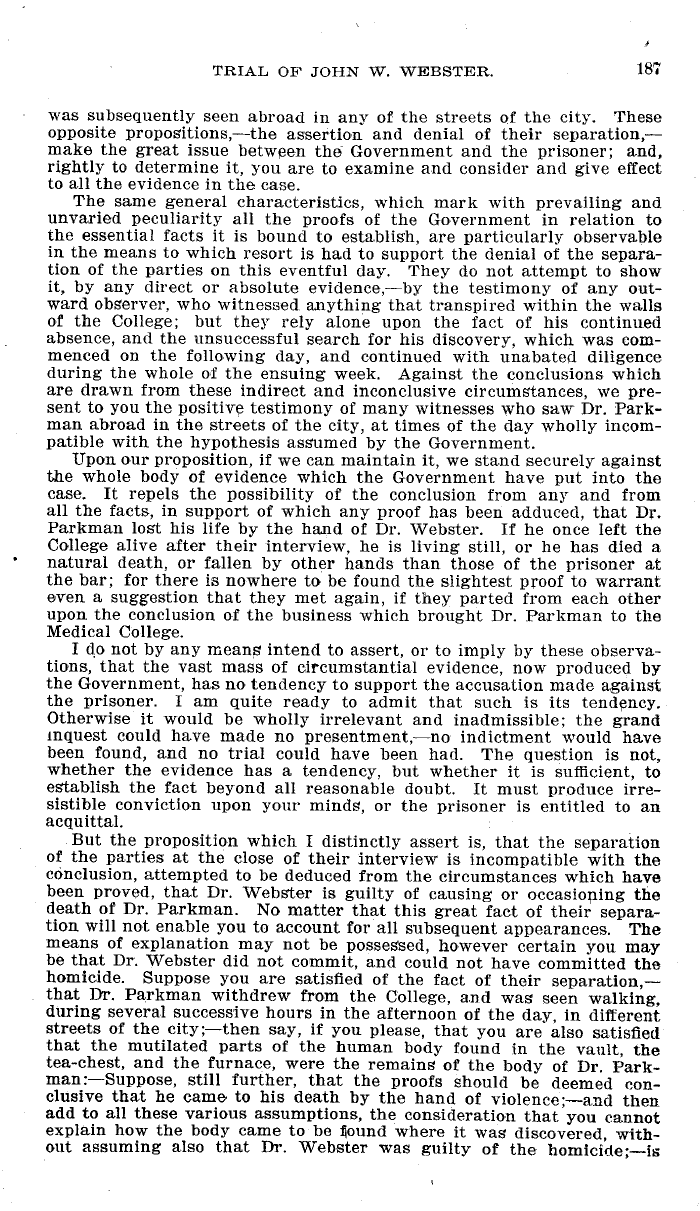|
TRIAL OF JOHN W. WEBSTER. 187
was subsequently seen abroad in any of the streets of the city. These
opposite propositions,-the assertion and denial of their separation,-
make the great issue between the Government and the prisoner; and,
rightly to determine it, you are to examine and consider and give effect
to all the evidence in the case.
The same general characteristics, which mark with prevailing and
unvaried peculiarity all the proofs of the Government in relation to
the essential facts it is bound to establish, are particularly observable
in the means to which resort is had to support the denial of the separa-
tion of the parties on this eventful day. They do not attempt to show
it, by any direct or absolute evidence,-by the testimony of any out-
ward observer, who witnessed anything that transpired within the walls
of the College; but they rely alone upon the fact of his continued
absence, and the unsuccessful search for his discovery, which was com-
menced on the following day, and continued with unabated diligence
during the whole of the ensuing week. Against the conclusions which
are drawn from these indirect and inconclusive circumstances, we pre-
sent to you the positive testimony of many witnesses who saw Dr. Park-
man abroad in the streets of the city, at times of the day wholly incom-
patible with the hypothesis assumed by the Government.
Upon our proposition, if we can maintain it, we stand securely against
the whole body of evidence which the Government have put into the
case. It repels the possibility of the conclusion from any and from
all the facts, in support of which any proof has been adduced, that Dr.
Parkman lost his life by the hand of Dr. Webster. If he once left the
College alive after their interview, he is living still, or he has died a
natural death, or fallen by other hands than those of the prisoner at
the bar; for there is nowhere to be found the slightest proof to warrant
even a suggestion that they met again, if they parted from each other
upon the conclusion of the business which brought Dr. Parkman to the
Medical College.
I do not by any means intend to assert, or to imply by these observa-
tions, that the vast mass of circumstantial evidence, now produced by
the Government, has no tendency to support the accusation made against
the prisoner. I am quite ready to admit that, such is its tendency.
Otherwise it would be wholly irrelevant and inadmissible; the grand
inquest could have made no presentment,-no indictment would have
been found, and no trial could have been had. The question is not,
whether the evidence has a tendency, but whether it is sufficient, to
establish the fact beyond all reasonable doubt. It must produce irre-
sistible conviction upon your minds, or the prisoner is entitled to an
acquittal.
But the proposition which I distinctly assert is, that the separation
of the parties at the close of their interview is incompatible with the
conclusion, attempted to be deduced from the circumstances which have
been proved, that Dr. Webster is guilty of causing or occasioning the
death of Dr. Parkman. No matter that this great fact of their separa-
tion will not enable you to account for all subsequent appearances. The
means of explanation may not be possessed, however certain you may
be that Dr. Webster did not commit, and could not have committed the
homicide. Suppose you are satisfied of the fact of their separation,-
that Dr. Parkman withdrew from the College, and was seen walking,
during several successive hours in the afternoon of the day, in different
streets of the city; then say, if you please, that you are also satisfied
that the mutilated parts of the human body found in the vault, the
tea-chest, and the furnace, were the remains of the body of Dr. Park-
man:-Suppose, still further, that the proofs should be deemed con-
clusive that he came. to his death by the hand of violence; and then
add to all these various assumptions, the consideration that you cannot
explain how the body came to be ifound where it was discovered, with-
out assuming also that Dr. Webster was guilty of the homicide; is
|

